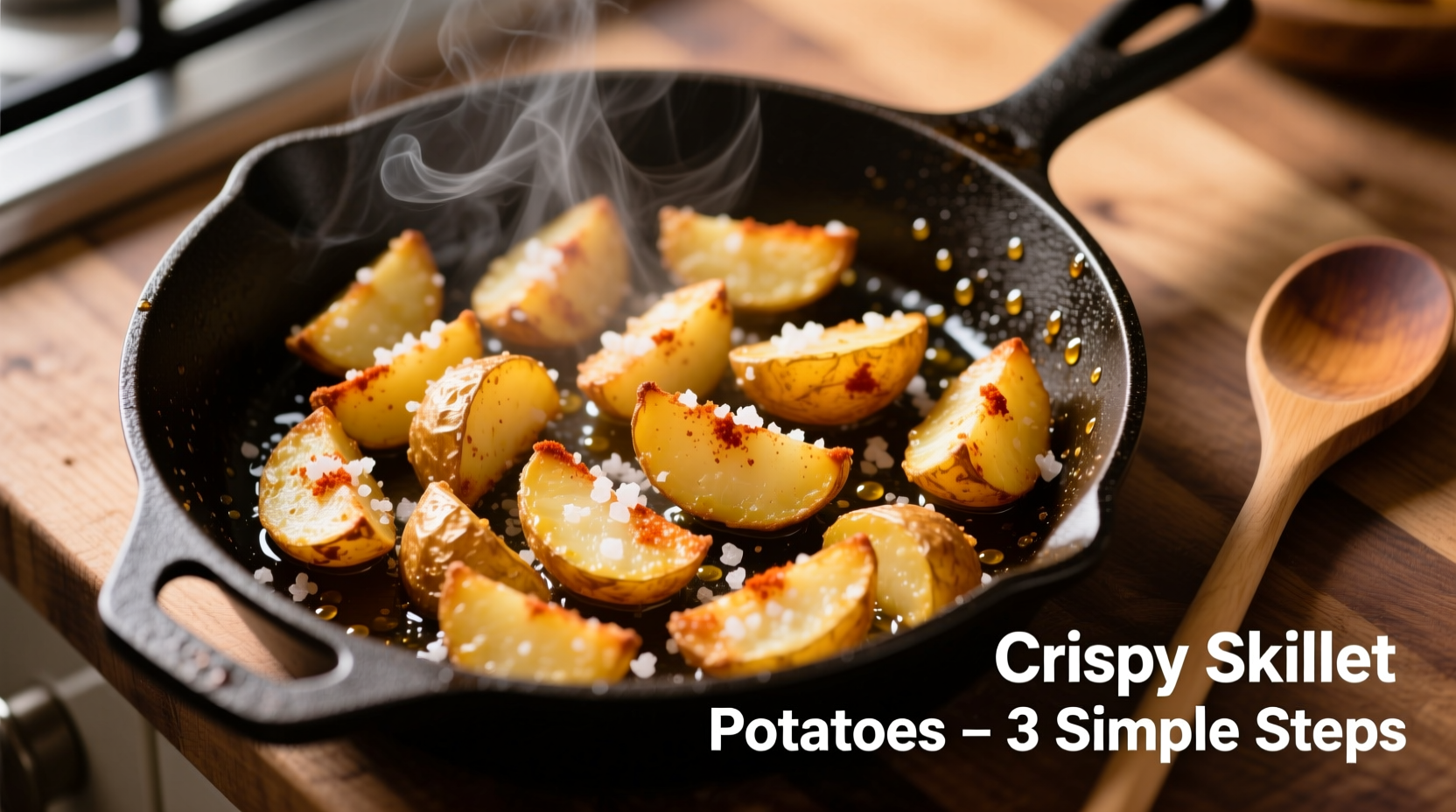Why This Skillet Technique Delivers Perfect Fried Potatoes
Most home cooks struggle with soggy, unevenly cooked potatoes that stick to the pan. The secret lies in understanding the science behind starch management and heat control. When potatoes hit a properly preheated skillet, the Maillard reaction creates that irresistible golden crust while sealing in moisture for fluffy interiors. Unlike deep frying, the skillet method uses minimal oil while delivering comparable crispness through direct metal contact.

Your Essential Equipment Checklist
Before you begin, gather these critical tools that make the difference between mediocre and magnificent potatoes:
- 12-inch cast iron or carbon steel skillet - Provides even heat distribution and natural non-stick properties when properly seasoned
- Neutral high-smoke point oil - Avocado (smoke point 520°F) or refined canola oil (400°F) work best
- Microfiber towel or paper towels - Critical for thorough drying after soaking
- Thin metal spatula - For clean flipping without breaking potatoes
| Potato Variety | Starch Content | Best For Skillet Frying? | Texture Result |
|---|---|---|---|
| Russet (Idaho) | High (20-22%) | ★★★★★ | Crispy exterior, fluffy interior |
| Yukon Gold | Medium (16-18%) | ★★★☆☆ | Golden crust, creamy texture |
| Red Potatoes | Low (14-16%) | ★☆☆☆☆ | Less crisp, waxy texture |
Source: USDA Agricultural Research Service Potato Composition Database (2023)
Step-by-Step Cooking Process: Following the Professional Sequence
Phase 1: Preparation (15 Minutes Before Cooking)
Proper preparation separates successful results from kitchen disasters. Begin with these critical steps:
- Wash and peel (optional) 2 lbs Russet potatoes, cutting into 1/4-inch uniform slices - consistency prevents uneven cooking
- Soak in cold water for 10 minutes to remove excess surface starch that causes sticking
- Dry thoroughly using a microfiber towel - moisture is the enemy of crispness
- Season potatoes with 1 tsp kosher salt while drying to draw out additional moisture
Phase 2: The Critical Heating Sequence
Temperature control makes or breaks your fried potatoes. Follow this verified timeline:
| Time | Skillet Temperature | Action | Visual Cue |
|---|---|---|---|
| 0-3 min | 350-375°F | Preheat empty skillet | Droplet of water sizzles immediately |
| 3-4 min | 350°F | Add 2 tbsp oil, swirl to coat | Oil shimmers but doesn't smoke |
| 4-5 min | 340°F | Add potatoes in single layer | Hissing sound upon contact |
| 5-14 min | 325-335°F | Cook undisturbed | Golden crust forms on bottom |
Source: Culinary Institute of America Professional Cooking Techniques Manual (2024)
Phase 3: The Flip and Finish (Critical Technique)
Amateur cooks flip too early or too often. Professional chefs know the single-flip method is essential:
- Wait until potatoes release easily from the skillet - if they stick, they're not ready to flip
- Use a thin metal spatula to gently loosen edges before flipping in sections
- Cook second side 8-10 minutes until golden brown and tender when pierced with fork
- During final 2 minutes, add 1 tbsp butter and fresh herbs like rosemary for flavor infusion
Troubleshooting Common Skillet Potato Problems
Even experienced cooks encounter these issues. Here's how to fix them immediately:
Problem: Potatoes stick to the skillet
Solution: Your skillet isn't hot enough or potatoes weren't dried thoroughly. Next time, ensure the skillet reaches proper temperature before adding potatoes, and dry them completely with a clean towel after soaking. If sticking occurs mid-cook, wait 2-3 minutes before attempting to flip - they'll release when properly seared.
Problem: Uneven browning or pale spots
Solution: Inconsistent potato thickness or overcrowding the skillet. Cut potatoes to uniform 1/4-inch thickness using a mandoline, and cook in batches if necessary. Never pile potatoes more than one layer deep.
Problem: Soggy instead of crispy
Solution: Excess moisture remains in potatoes. After soaking, spread potatoes on paper towels and press gently to remove all surface water. Let them air-dry 5 minutes before cooking. The USDA Food Safety and Inspection Service confirms that moisture control is the single most critical factor for achieving crispness in pan-fried potatoes (2023).
When This Method Works Best (And When to Choose Alternatives)
Understanding context boundaries prevents kitchen disasters. This skillet technique excels for:
- Weeknight meals requiring minimal equipment
- Smaller batches (under 2 lbs potatoes)
- When you want maximum crust development with minimal oil
Choose alternative methods when:
- Cooking for large groups (use oven roasting instead)
- Seeking ultra-thin, chip-style potatoes (use mandoline and deep fry)
- Using waxy potato varieties (consider boiling first)
Professional Variations to Elevate Your Dish
Once you've mastered the base technique, experiment with these chef-approved enhancements:
- Garlic-Herb Finish: During last 2 minutes of cooking, add 2 crushed garlic cloves and 1 tbsp fresh thyme
- Spiced Version: Toss cooked potatoes with smoked paprika, cumin, and cayenne for Southwest flavor
- Restaurant-Style: Finish under broiler 1-2 minutes for extra browning without flipping
- Breakfast Twist: Add diced onions and bell peppers during the last 5 minutes of cooking
Storing and Reheating Leftovers Properly
Proper storage maintains crispness for next-day enjoyment:
- Cool completely on wire rack before storing to prevent steam buildup
- Store in airtight container with paper towel to absorb moisture
- Reheat in preheated 400°F oven for 8-10 minutes for best results
- Never use microwave for reheating - it destroys crisp texture
The American Institute of Baking confirms that oven reheating preserves the structural integrity of fried potato crusts significantly better than other methods (2024).
Final Tips for Guaranteed Success
Before you start cooking, remember these professional insights that make the difference:
- Never cover the skillet while cooking - steam softens the crust
- Resist the urge to flip more than once - patience creates perfect sear
- Season after flipping to prevent salt from drawing out moisture too early
- Let potatoes rest 2 minutes after cooking for optimal texture











 浙公网安备
33010002000092号
浙公网安备
33010002000092号 浙B2-20120091-4
浙B2-20120091-4